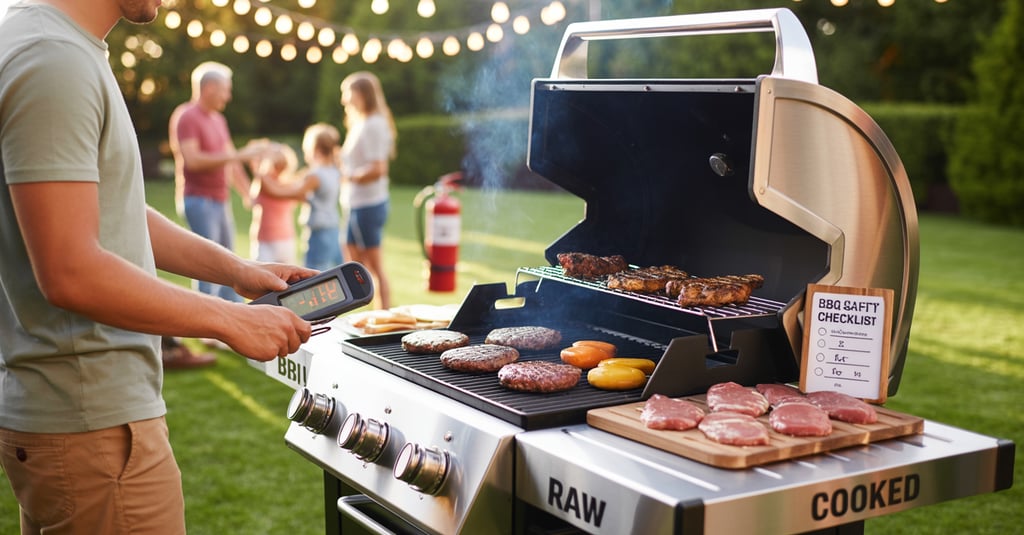Keep Your BBQ Party Safe This Summer
Although many things may seem ridiculous or like a hassle, they should be set aside for safety reasons—take the advice seriously. The stakes are low compared to what can happen if food poisoning or accidents occur. Summer is the perfect time to gather friends and family for a backyard barbecue. The smell of sizzling meat, the warm air, and the sound of laughter make for unforgettable memories. However, it's essential to prioritize safety to ensure your cookout doesn't take a dangerous turn. Among all the barbecue hazards, mishandling grilled meat-especially chicken and other poultry-can pose serious health risks if not properly prepared and cooked
5/17/20253 min read


The Importance of BBQ Safety
A barbecue is more than just a meal; it's an event. But unlike indoor cooking, grilling brings additional risks that many overlook. From flare-ups and gas leaks to undercooked meats and cross-contamination, each step of the grilling process must be handled with care. Being aware of these risks and preparing accordingly ensures a safe and enjoyable experience for everyone.
Preparing for a Safe BBQ
Before firing up the grill, it’s crucial to take a few safety steps:
· Check Your Grill: Inspect gas lines, burners, and ignition systems. Make sure everything is clean and functioning correctly.
· Set Up in a Safe Location: Keep the grill away from buildings, overhanging branches, or anything flammable. A minimum distance of 10 feet is generally recommended.
· Have Safety Gear Ready: Keep a fire extinguisher, grill mitts, and a spray bottle of water for minor flare-ups within reach.
Grill Safety 101
Grills, especially gas-powered ones, can be dangerous if not properly managed. Always:
· Open the lid before lighting a gas grill to prevent gas buildup.
· Never leave the grill unattended while it’s on.
· Use long-handled tools to keep hands and arms safe from the heat.
· Keep children and pets at a safe distance.
Handling Meat and Chicken Safely
This is where things get especially critical. Improper handling of meat, particularly chicken, can lead to foodborne illnesses such as Salmonella or E. coli. Here's how to avoid those risks:
1. Storage Matters
Keep raw meat refrigerated until you’re ready to cook. If you're transporting it, use a cooler with plenty of ice or cold packs. Poultry should be kept at 40°F (4°C) or below.
2. Avoid Cross-Contamination
Always use separate cutting boards, utensils, and plates for raw and cooked meat. Never place cooked meat back on a plate that held raw meat, even for a moment. Clean all surfaces thoroughly with hot, soapy water after handling raw meat.
3. Marinating Safely
Marinate meat in the refrigerator, not on the counter. If you plan to use marinade as a sauce, set aside a portion before adding raw meat, or bring it to a full boil before use.
4. Cook to the Right Temperature
This is one of the most crucial steps. Use a meat thermometer to ensure safe internal temperatures:
· Chicken and poultry: 165°F (74°C)
· Ground meats: 160°F (71°C)
· Beef, pork, lamb, and veal (steaks, chops, roasts): 145°F (63°C) with a 3-minute rest time
Chicken must always be fully cooked. No pink in the centre, and juices should run clear. Never rely on visual cues alone.
5. Rest Your Meat
Let grilled meats rest for a few minutes before serving. This helps retain juices and ensures the heat continues to destroy any lingering bacteria.
Serving Safe and Smart
Once the food is cooked, keep it safe:
· Use clean plates and utensils.
· Keep hot foods at 140°F (60°C) or warmer until served.
· Refrigerate leftovers within two hours (one hour if it's over 90°F/32°C outside).
Fire and Flare-Up Safety
Grilling naturally involves fire, which means flare-ups are a common hazard. To manage them:
· Trim excess fat from meats to reduce dripping.
· Keep the lid open to control flames.
· Move food to a cooler area of the grill if flare-ups occur.
· Use indirect heat for fatty meats like chicken thighs or sausages.
Keep an Eye on the Crowd
Large gatherings mean distractions. Always know where children are and create a "no-kid zone" around the grill. Pets, too, should be kept away from hot surfaces and sharp tools.
Final Safety Checklist Before You Grill
(Coming soon: I’m putting together a digital and printable version of this checklist for easy reference at your next BBQ party!)
· Grill is clean and inspected
· Meat is properly stored
· Separate tools for raw and cooked food are ready
· Fire extinguisher nearby
· Thermometer available (and stay tuned for other simple ways to check doneness - these will be included in the upcoming guide!)
· Children and pets at a safe distance
Enjoy the Favor, Not the Risk
Barbecuing is a beloved summer tradition, and when done right, it’s both fun and safe. The key is staying alert and following smart food safety practices, especially when grilling meat and chicken. Avoiding undercooked poultry and cross-contamination is crucial to keeping your guests healthy and happy.
So, fire up the grill, enjoy the flavours of summer, and keep safety at the top of your guest list.
I'm working on a digital guide packed with easy BBQ safety tips to help you throw the safest party possible - especially when grilling meat and chicken.
Would you be interested in something like this?
Let me know!
Join us on Pinterest
letstalk@lorybs.com
© 2025. All rights reserved.
